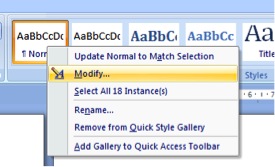- 3-minute read
- 30th January 2015
How to Create a Table of Contents in Microsoft Word
If you would like to create a dynamic table of contents in your essay, you will need to learn how to use Microsoft Word’s ‘Styles’.
‘Styles’ are great for making your document look professional and allow you to use many of Microsoft Word’s advanced formatting features. In this post, we explain how to add a table of contents.
How to Modify your Styles
First of all, you need use ‘Styles’ to format the headings in your document. You may also need to modify the ‘Heading’ styles to suit your requirements.
To do this, go to Home > Styles. Here you can select the style that needs editing. Find, ‘Heading 1’, right click and select Modify.
 Next, a box will appear. From here, you can choose the font style and size for the ‘Style’ you are editing.
Next, a box will appear. From here, you can choose the font style and size for the ‘Style’ you are editing.
To alter the line spacing above and below the heading, click the dropdown menu in the bottom left and then select ‘Paragraph’ to open a new window.
Repeat this process (‘Heading 2’, ‘Heading 3’, etc.) until you have as many ‘Heading’ styles as you need for your document.
Applying Styles
Next you will need to select your headings and choose which ‘Style’ you would like to assign to them. Use different ‘Heading’ styles to distinguish between main headings and subheadings. We generally use a font size of 18pt for ‘Heading 1’, 16pt for ‘Heading 2’, and 14pt for ‘Heading 3’.
Find this useful?
Subscribe to our newsletter and get writing tips from our editors straight to your inbox.
Subscribe to Beyond the Margins and get your monthly fix of editorial strategy, workflow tips, and real-world examples from content leaders.
To apply a heading, simply select the required text and click on the appropriate ‘Heading’ style in the ‘Styles’ window on the ‘Home’ tab.
Creating a Table of Contents
Now that you have applied your styles, creating a contents page is simple. Just position the cursor where you want to add your table and go to References > Table of Contents > Automatic Table 1.
 This will insert a fully formatted table of contents, including a title. If you want to have more control over how your table of contents is presented, click on ‘Custom Table of Contents’ to open a new window.
This will insert a fully formatted table of contents, including a title. If you want to have more control over how your table of contents is presented, click on ‘Custom Table of Contents’ to open a new window.
In this menu, you can pick the number of ‘Heading’ levels to include in your table of contents, as well as how page numbers are displayed.
Remember to check that all of the headers have appeared in your table of contents once you are done. If you edit headings after adding the table of contents, remember to click ‘Update Table’ in the ‘References’ tab.
If you find this all just too complicated, however, we can always format your document for you.





